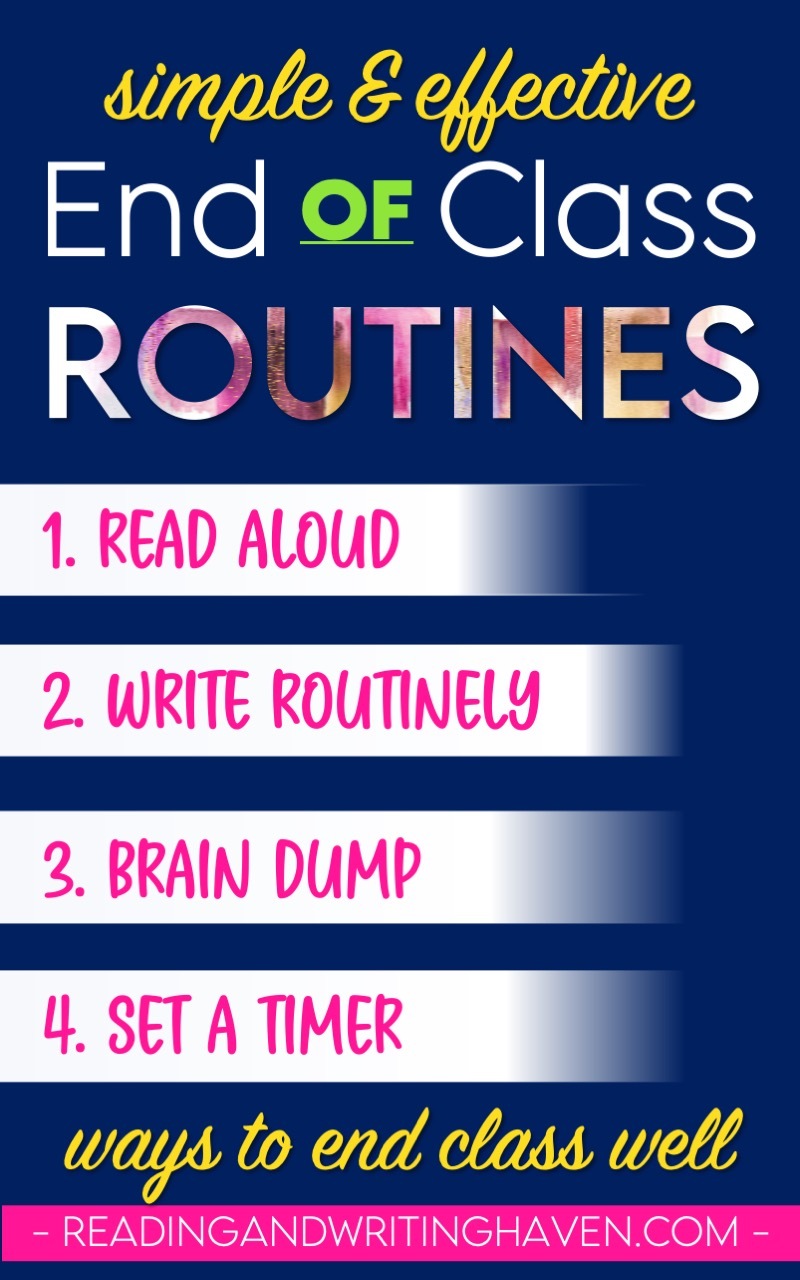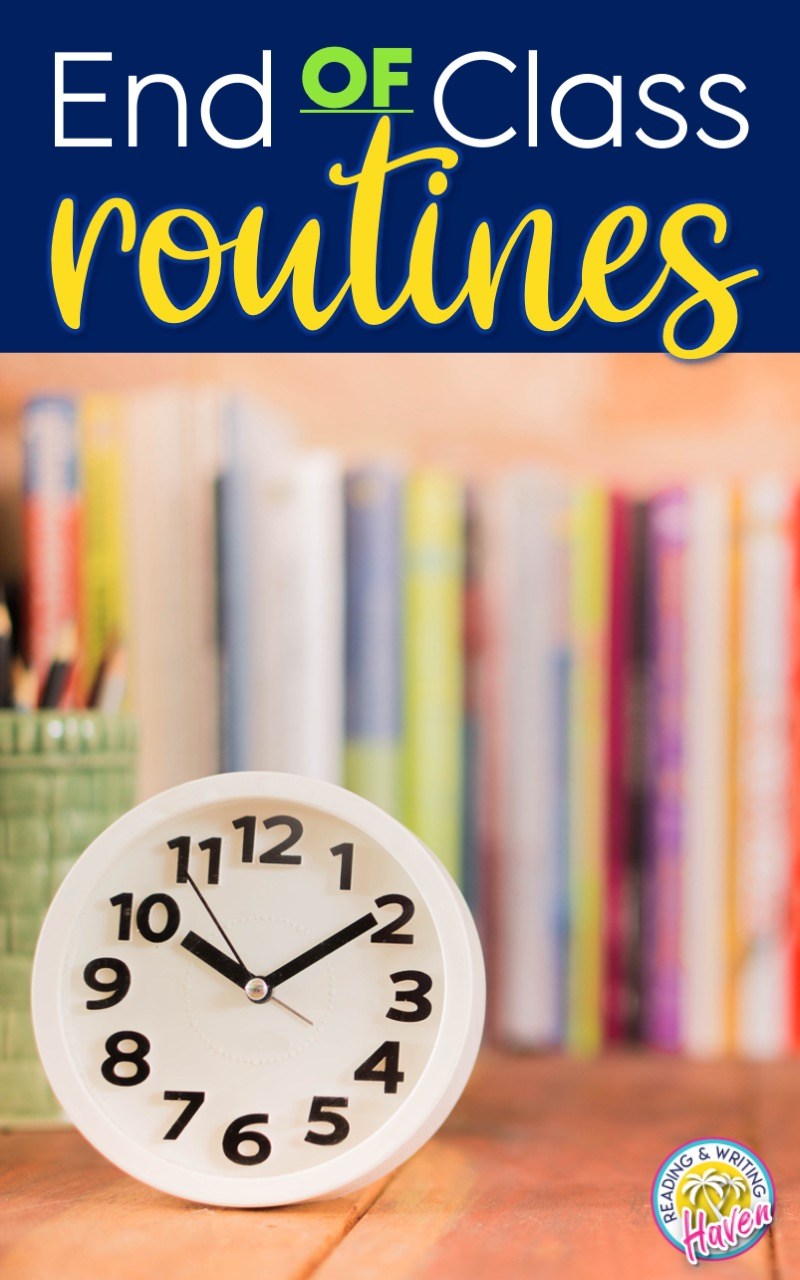My Favorite End-of-Class Routine Ideas: Calming the Chaos
What do your students do at the end of the class period? Do those last few minutes ever feel chaotic or unorganized? Without a structured routine, students will often line up at the door, tease one another, stand on desks…you name it! Classroom routines provide predictability and structure many students appreciate (even the ones who wouldn’t tell you so). That’s why an end-of-class routine is just as important as bell ringers and other management strategies.
When it comes to routines, I like to keep it simple. If they aren’t easy and effective, I know I won’t stick with them. So, here are four end-of-class routines that won’t waste anyone’s time!
READ ALOUD
Pick a really good book. Read it aloud to students at the end of each class period. Why?
- Students are naturally calmed when being read to out loud.
- It will support your already existing, rich literacy culture.
- Read alouds engage everyone – even reluctant readers.
- You can use the novel as a mentor texts with your reading lessons.
- Students will benefit from hearing fluent reading with intonation.
To make read alouds the most effective, I have a few suggestions. For one, if possible, don’t use an audio book. Read alouds really are more engaging for students when a teacher is reading the book. Also, use a sticky note to mark where you leave off at the end of each day. Finally, make sure students have packed up their things and have their desks cleared off before beginning to read. As students clean up their workspace, you can provide context as to where they left off the previous day.
Of course, reading aloud isn’t the only simple option for an end-of-class routine.
WRITE ROUTINELY
Write routinely for a variety of purposes. It’s a standard, but what does it mean?!
According to Gallagher, students need to write more than we can grade…even more than we can read! To become strong writers, volume and frequency matter, just like with reading.
So, why not implement an end-of-class routine that allows for informal, regular writing practice? Students can choose from a variety of prompt styles, audiences, and purposes. Each day, they pick up where they left off the previous day.
They can write about topics that interest them, or you can select questions that highlight skills you want them to practice. Think, transitions, sentence types, figurative language, or vocabulary usage.
The scariest part about using writing as an end-of-class routine is the notion that you have to grade it all. Of course, you don’t! You can comment on students’ entries when time allows. Or, you can provide time for students to offer feedback on one another’s writing. You may even decide to have them choose the piece they are most proud of to submit for grading.
When using writing as an end-of-class routine, it doesn’t really matter how many prompts students answer or pieces they complete. The emphasis is more on choice and the value of the writing process…on exploring which genre of writing is best for the intended audience and purpose. Students’ work can also be used as a foundation for writing conferences.
Need a variety of prompts that are ready to go? I’m a collaborative author on TeachWriting.org. As a subscriber, you can gain access to 100 writing prompts that cover a variety of genres and are ready-to-use as bell ringers or exit activities.
EXIT ACTIVITY
Why not use the end of class for an exit ticket or activity? Consider more specific options like these…
Brain Dumps – A brain dump is an opportunity for students to clear out the mental clutter they’ve accumulated during a class period. Simply remembering and recording the biggest take aways or highlights from a lesson is extremely helpful for long-term learning. Ask students to write down
Goals & Reflections – If you have students set goals for your course, for independent reading, or for executive functioning skills, don’t forget to give them time to reflect on and redirect those goals when necessary. Exit tickets can be a convenient space.
SEL Check-in – Use the last few minutes of class as an opportunity to check in with students for social emotional purposes. Ask questions that build relationships with them, give them time to practice some mindfulness or deep breathing, or hold a brief classroom meeting.
Reading Ladder – If you use my reading ladder (digital and print) or some other non-invasive method for tracking reading progress, use one day each week at the end of class to update the ladder. This prioritizes the importance of reflecting on reading volume, diet, and identity.
Skill Reinforcement – Use your end-of-class exit activity as a formative assessment opportunity. Did you teach a grammar lesson? … a new vocabulary word? … a writing skill? … a reading strategy? Ask a question that will give you the data you need to direct the next lesson.
SET A TIMER
One of my colleagues introduced me to this strategy. Our school switched the passing period times to reduce the number of students in the hallway, but that resulted in not all passing periods being marked by bells. For middle school, that was a hot mess. Her solution? Set a timer.
Students will work and stay focused if they know there will be a specific indicator that it’s time to stop. So, try setting a timer for a minute or two before the end of class. (Depending on what you do next, you may even want to allow yourself more time.)
With the one plus minutes after the timer before the end of class, have students write down homework assignments, turn in work, clean up workspaces, and pack up belongings. There will be less zipping of binders and getting out of seats when you are talking if students know they will have time to get organized and prepare for departure.
These end-of-class routines work well for providing a predictable structure while allowing flexibility and engagement. If you choose to vary your end-of-class routine (by quarter, for example), make sure to take time to teach students what to expect. Instead of just telling students what to do, practice the new routine with your class until everyone is benefiting.
__________________________________


